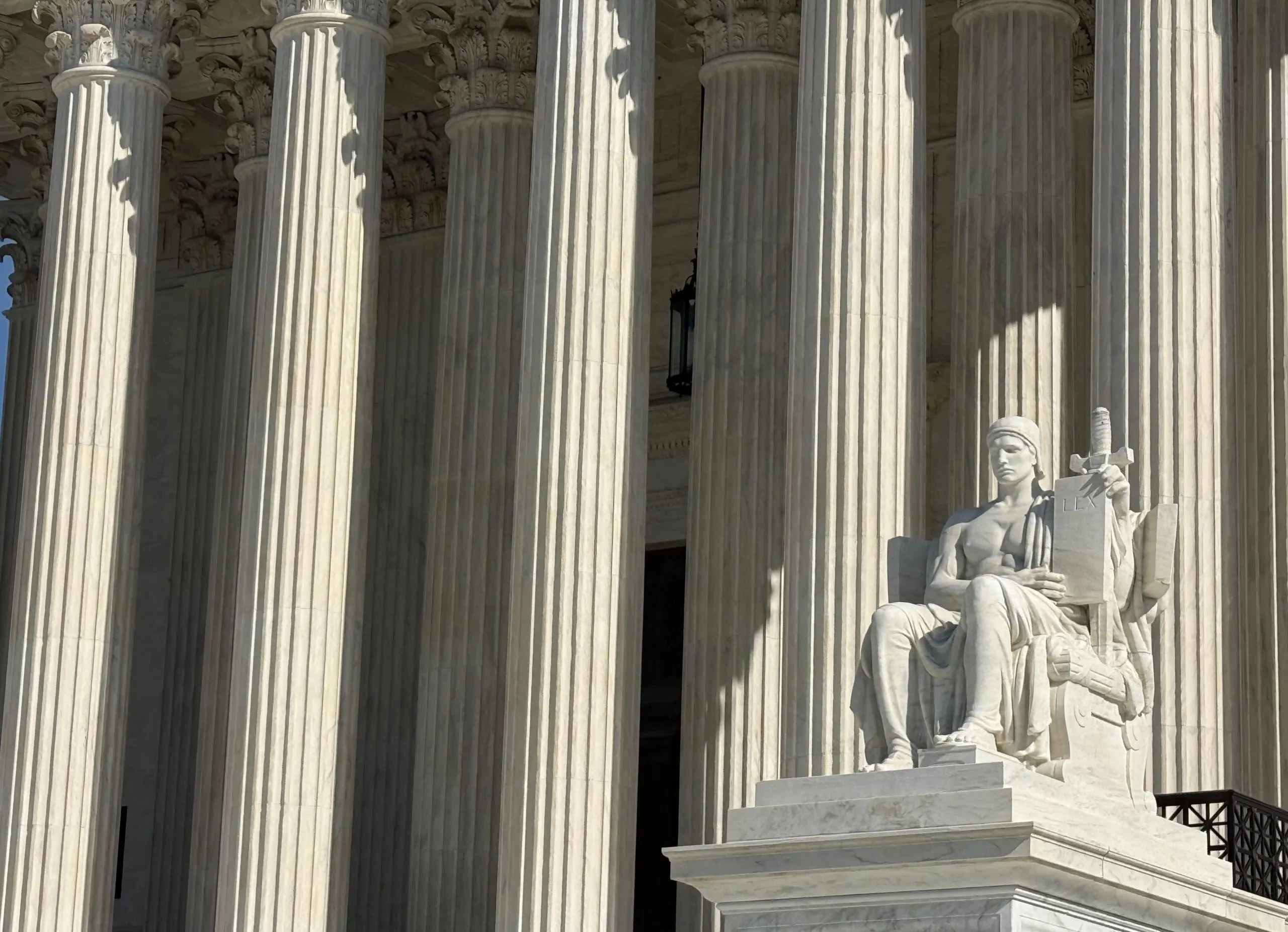Court to consider prison inmate’s religious liberty claims


On Monday, the Supreme Court will hear oral arguments in the case of Damon Landor. Landor is a Louisiana man who grew long dreadlocks for religious reasons. In 2020, prison officials forcibly shaved his head even after he showed them a copy of a federal appeals court ruling affirming his right to keep the dreadlocks. The justices will now decide whether Landor can try to recover money damages from those officials.
The federal law at the center of the case is known as the Religious Land Use and Institutionalized Persons Act. Enacted 25 years ago, it applies to state prisons that receive federal funding (among other places), and bars the government from imposing a substantial burden on religious exercise unless the imposition is the least restrictive means of furthering a compelling government interest. It also allows individuals to bring suits against the government and government officials for violations of the law, for “appropriate relief.”
RLUIPA was enacted seven years after the Religious Freedom Restoration Act, which was in turn enacted in response to the Supreme Court’s decision in Employment Division v. Smith. In Smith, the court held that the First Amendment’s guarantee of the right to freely exercise one’s religion does not exempt individuals from the need to comply with laws that are neutral and apply to everyone. Moreover, the court held, the government does not need to show that it has a compelling interest in applying that law to a specific person. RFRA was originally intended to apply to federal, state, and local governments, but the Supreme Court in 1997 limited RFRA to the federal government. RLUIPA was Congress’ effort to strengthen at least some state-level protections.
Landar is a devout Rastafarian. For almost 20 years, he adhered to a promise that he made – known as the Nazarite Vow – to grow his hair without cutting it. But just three weeks before he finished serving a five-month sentence in the Louisiana prison system, he was transferred to the Raymond Laborde Correctional Center. When he arrived at that facility, Landor tried to explain his religious beliefs and provided a prison guard with a copy of a ruling by the U.S. Court of Appeals for the 5th Circuit holding that RLUIPA required the prison to allow him to keep his dreadlocks. Prison officials, however, threw the opinion in the trash, handcuffed Landor to a chair, “and shaved him bald. In an instant,” Landor wrote, “they stripped him of decades of religious practice at the heart of his identity.”
Landor filed a lawsuit under RLUIPA in federal court against the state and against the prison officials in both their individual and official capacities. The district court dismissed the claims against the prison officials in their individual capacities, holding that RLUIPA does not allow private individuals to bring such claims seeking money damages.
After the 5th Circuit upheld that ruling, Landor came to the Supreme Court, asking the justices to weigh in – which they agreed in June to do.
In his brief on the merits, Landor pointed to the Supreme Court’s 2020 decision in Tanzin v. Tanvir, holding that “appropriate relief” under the Religious Freedom Restoration Act can include money damages in lawsuits brought against government officials in their individual capacities, and contended that he can sue the prison officials under RLUIPA for money damages as well. He observed that if he had been in federal prison when his head was forcibly shaved, he could have sued the officials responsible for shaving him in their personal capacity under RFRA. Because the relevant text of RLUIPA is the same as RFRA, he told the court, and the Supreme Court “reads RLUIPA and RFRA together as ‘sisters,’” RLUPIA “clearly provides the same remedies” as RFRA.
Landor added that if he cannot obtain damages from the officials, he will effectively not have any relief available to him at all. “There would be no remedy, no accountability, and RLUIPA’s soaring promise would ring hollow,” he said.
The availability of damages is especially important for prisoners under RLUIPA, Landor emphasized, because many of their claims “involve one-time incidents that can be remedied only via damages” and because claims for forward-looking relief (such as an order instructing prison officials not to repeat the conduct) are no longer valid if a prisoner is released or moved. This case, Landor said, provides a “stark example”: Landor’s sentence was just five months, “he was transferred twice, and the assault occurred with only a few weeks remaining on his sentence.” What’s more, after Landor’s head was shaved, he was held in lockdown, which kept him from being able to file a grievance until he was released – which meant that any forward-looking relief would not have helped him. “Under the court of appeals’ approach, state officials thus could violate RLUIPA’s clear command and unilaterally prevent the victim from obtaining any relief.”
If RLUIPA does not allow damages against officials in their personal capacity, Landor emphasized, there is nothing to deter officials from “do[ing] the same thing tomorrow.” Prison officials “could deny Kosher meals to Jewish inmates for failing to be Orthodox, force Muslim inmates to choose between observing a halal diet or suffering malnutrition, or entirely block access to Christian communion and church services.”
Nor, according to Landor, does holding prison officials personally liable under RLUIPA conflict with Congress’ power under the Constitution’s spending clause, which allows it to make the availability of federal funds hinge on the recipient’s agreement to comply with specific conditions. Congress, Landor argued, can make federal funds for prisons contingent on a state’s agreement that officers will either accommodate prisoners’ religious exercise or be potentially subject to (among other things) personal liability. And under the Supreme Court’s cases, Landor continued, officials can be held personally liable under RLUIPA even if they are not the direct recipients of the federal funds.
Louisiana and the prison officials counter that Landor’s “‘claim of expansive authority’ under RLUIPA ‘is unprecedented.’” “Congress,” they wrote, “apparently has never otherwise attempted to wield its spending power to create a private right of action against non-recipients” of federal funding.
To the extent that RLUIPA allows lawsuits against state employees acting in their personal capacity, the state continued, it violates the Constitution because those employees are not part of the contract between the federal government and the states and do not receive federal funds. Therefore, they cannot have agreed to be bound by RLUIPA. Indeed, the state noted, neither Landor nor the briefs supporting him “cite a single case where Congress tried to impose a spending-power condition on a non-recipient.”
And even if RLUIPA arguably did allow Landor’s lawsuit against the individual officials, the state said, Congress did not “clearly and unambiguously authorize” lawsuits against those employees seeking money damages. Instead, it used the term “appropriate relief,” which is “open-ended.” Congress has even more of a responsibility to speak very clearly, the state added, when it is intruding on the traditional balance of powers between the states, which have a strong interest in being able to run their prisons as they see fit, and the federal government.
Moreover, the state contended, it has long been settled that accepting federal funds “does not trigger the availability of individual-capacity claims for damages under the Religious Land Use and Institutionalized Persons Act.” States have entered into contracts with the federal government with that understanding “for decades.” The Supreme Court’s decision in Tanzin doesn’t change that, because it was interpreting RFRA (which applies only to the federal government) and therefore “had nothing to do with the Spending Clause.”
The state acknowledged that “RLUIPA as it has existed for a quarter century will not remedy every possible burden on religious exercise.” That does not mean, the state stressed, that RLUIPA has no use whatsoever just because a plaintiff like Landor cannot recover money damages from the prison officials in their personal capacity.
Alternatively, the state argues that RLUIPA is likely unconstitutional under the Supreme Court’s 2012 decision in National Federation of Independent Business v. Sebelius, in which a majority of the justices upheld the Affordable Care Act’s individual mandate as a tax but also ruled that a condition threatening all Medicaid funds – which state prisons receive – violates the Constitution because it is coercive. “If the only way for the States to say no to RLUIPA,” the state argued, “is to withdraw from Medicaid, that ‘is a gun to the head’ and this is NFIB all over again.”
Landor enjoys a massive – 22-1 – advantage over the state in the number of “friend of the court” briefs filed supporting him. Only the National Sheriffs’ Association filed a brief supporting the state and prison officials, while the briefs supporting Landor included groups ranging from the conservative American Center for Law and Justice to a group of religious and civil-rights organizations that includes the Americans United for the Separation of Church and State and People for the American Way.
But the most significant brief supporting Landor likely comes from the federal government, which told the justices that RLUIPA was intended to “broadly protect individual religious exercise.” U.S. Solicitor General D. John Sauer acknowledged that 14 years ago, the Supreme Court in Sossamon v. Texas held that RLUIPA’s reference to “appropriate relief” does not allow claims for money damages against a state itself. But that ruling, Sauer wrote, “was based on considerations of sovereign immunity inapplicable to suits against individual officials.”
A decision in the case is expected by summer.
Disclosure: Amy Howe was among the lawyers representing Harvey Sossamon in the Supreme Court in Sossamon v. Texas.
Posted in Court News, Merits Cases
Cases: Landor v. Louisiana Department of Corrections and Public Safety